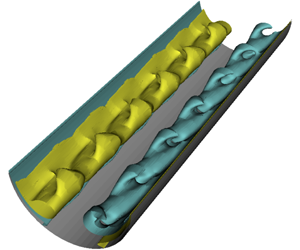Published online by Cambridge University Press: 07 January 2020

We study the convective patterns that arise in a nearly semicylindrical cavity fed in with hot fluid at the upper boundary, bounded by a cold, porous semicircular boundary at the bottom, and infinitely extended in the third direction. While this configuration is relevant to continuous casting processes that are significantly more complex, we focus on the flow patterns associated with the particular form of mixed convection that arises in it. Linear stability analysis (LSA) and direct numerical simulations (DNS) are conducted, using the spectral-element method to identify observable states. The nature of the bifurcations is determined through Stuart–Landau analysis for completeness. The base flow consists of two counter-rotating rolls driven by the baroclinic imbalance due to the curved isothermal boundary. These are, however, suppressed by the through-flow, which is found to have a stabilising influence as soon as the Reynolds number  $Re$ based on the through-flow exceeds 25. For a sufficiently high Rayleigh number, this base flow is linearly unstable to three different modes, depending on
$Re$ based on the through-flow exceeds 25. For a sufficiently high Rayleigh number, this base flow is linearly unstable to three different modes, depending on  $Re$. For
$Re$. For  $Re\leqslant 75$, the rolls destabilise through a supercritical bifurcation into a travelling wave. For
$Re\leqslant 75$, the rolls destabilise through a supercritical bifurcation into a travelling wave. For  $100\leqslant Re\leqslant 110$, a subcritical bifurcation leads to a standing oscillatory mode, whereas for
$100\leqslant Re\leqslant 110$, a subcritical bifurcation leads to a standing oscillatory mode, whereas for  $Re\geqslant 150$, the unstable mode is non-oscillatory and grows out of a supercritical bifurcation. The DNS confirm that in all cases the dominant mode returned by the LSA precisely matches the topology and evolution of the flow patterns that arise out of the fully nonlinear dynamics.
$Re\geqslant 150$, the unstable mode is non-oscillatory and grows out of a supercritical bifurcation. The DNS confirm that in all cases the dominant mode returned by the LSA precisely matches the topology and evolution of the flow patterns that arise out of the fully nonlinear dynamics.